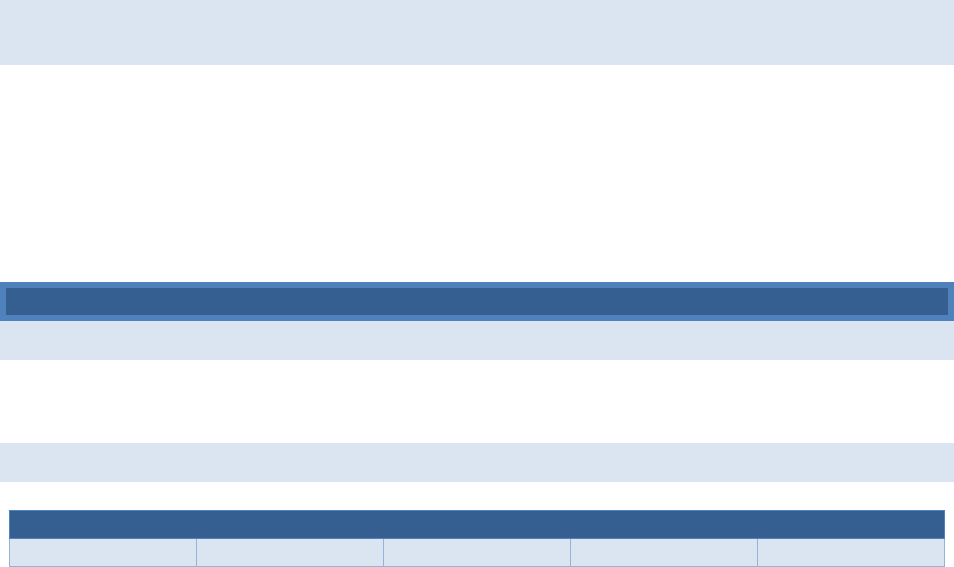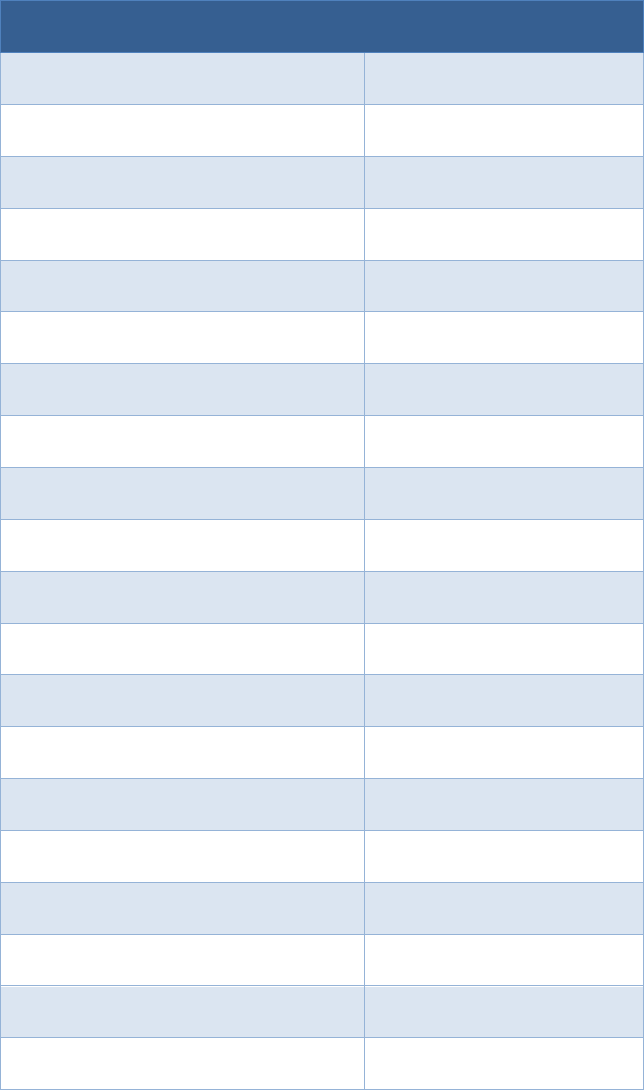
Updated: 11/03/2023
Resilient Food Systems Infrastructure Program
Program Scope and Requirements
Funding Opportunity Number: USDA-AMS-TM-RFSI-C-23-0001
State Plan Due Date: August 23, 2023, at 11:59 PM Eastern Time.

1
Program Solicitation Information
Funding Opportunity Title: Resilient Food Systems Infrastructure Program Cooperative Agreements
Funding Opportunity Number: USDA-AMS-TM-RFSI-C-23-0001
Announcement Type: Initial
Assistance Listing Number: 10.190
Funding Authorization: Section 1001(b)(4) of the American Rescue Plan (ARP) Act of 2021 (Pub. L. 117—
2), as amended, authorizes the United States Department of Agriculture (USDA), to make grants and
agreements to maintain and improve food and agricultural supply chain resiliency.
Eligible Entities: Eligible entities are departments of agriculture in States and Territories. The
department of agriculture in each State will serve as a Lead State agency, and AMS encourages them to
partner with at least one additional relevant state agency. The term 'State' means the 50 States, the
District of Columbia, the Commonwealth of Puerto Rico, Guam, American Samoa, the United States
Virgin Islands, and the Commonwealth of the Northern Mariana Islands.
Accessing for funds under this program is a three-step process (see section 1.4
for full details). After
entering into the initial cooperative agreement, States must submit an initial state plan describing their
program proposal, how it aligns with the program’s priorities and intent, and implementation plans.
Then, they will administer competitive programs for Infrastructure Grants. There is an additional option
project component for States to conduct supply-chain coordination activities.
State Plan Due Date: August 23, 2023, by 11:59 p.m. Eastern Time.
Executive Summary: The U.S. Department of Agriculture (USDA), Agricultural Marketing Service (AMS),
is entering into cooperative agreements with each U.S. State and Territory for Resilient Food Systems
Infrastructure Program Cooperative Agreements (RFSI). Following execution of the agreement, states
will submit State Plans to develop and administer coordinated initiatives to build resilience across the
middle-of-the-food-supply-chain in their state. Funds will support expanded capacity for the
aggregation, processing, manufacturing, storing, transporting, wholesaling, and distribution of locally
and regionally produced food products, including specialty crops, dairy, grains for human consumption,
aquaculture, and other food products, excluding meat and poultry. This program is intended to provide
similar support provided in other USDA funding for meat and poultry processing, but for the non-meat
and poultry sectors. States will work in partnership with USDA to make competitive subawards to
support infrastructure in the middle-of-the-supply-chain for domestic food and farm businesses and
other eligible entities. States may use a limited portion of funds to develop and/or strengthen the
State’s supply chain coordination and targeted market development services for local and regional
produced product.
Up to $420 million in American Rescue Plan funding is available for this program.
The overall goal of RFSI is to create more and better processing options for local and regional producers
across the specialty crops, dairy, grain (for food), and other sectors detailed in section 1.2.1
(i.e., non-
meat and poultry sectors) by targeting gaps and opportunities in the pandemic assistance, Food Systems
2
Transformation (FST) programs, and existing USDA grant programs that support the agricultural supply
chain.
AMS encourages applications that benefit Small and Underserved Business Owners, Historically
Underserved Farmers or Ranchers or for other businesses that qualify under the Small Business
Administration (SBA) categories of Small Disadvantaged Business, Women Owned Small Business, and
Veteran-Owned Small Businesses. For projects intending to serve these entities, applicants should
engage and involve those beneficiaries when developing projects and applications.
In all programs and initiatives, USDA promotes climate-resilient landscapes and rural economic systems,
including tools to support agriculture, forests, grazing lands, and rural communities. AMS encourages
applicants to consider including goals and activities related to mitigating and adapting to climate change
in their project’s design and implementation.

3
Table of Contents
Program Solicitation Information ..................................................................................... 1
Table of Contents ........................................................................................................... 3
1.0 Funding Opportunity Description ........................................................................... 4
1.1 Legislative Authority .......................................................................................... 4
1.2 Purpose ............................................................................................................ 4
1.3 Program Description .......................................................................................... 5
1.4 State Responsibilities ........................................................................................ 7
1.5 Infrastructure Grant Subaward Process ............................................................... 8
1.6 State-Led Complementary Supply Chain Coordination Activities .......................... 13
1.7 USDA Substantial Involvement in Cooperative Agreements with States................ 14
1.8 National Environmental Policy Act and Other Federal Laws and Regulations ........ 15
2.0 Award Information ............................................................................................... 15
2.1 Type of Federal Assistance ............................................................................... 15
2.2 Available Funding, Federal Award Period Duration, and Funding Formula ............ 15
3.0 Lead State Agency and Partners/Collaborators ....................................................... 18
3.1 Lead State Agency – Department of Agriculture ................................................. 18
3.2 Partners and Collaborators .............................................................................. 18
4.0 Funding Considerations ........................................................................................ 19
4.1 Cost Sharing and Matching ............................................................................... 19
4.2 Indirect Costs .................................................................................................. 19
4.3 Supplanting..................................................................................................... 20
4.4 Allowable and Unallowable Costs and Activities ................................................. 20
4.5 Coordinator Meeting Travel ............................................................................. 21
5.0 State Plan Submission Information ........................................................................ 21
5.1 Electronic Application Package ......................................................................... 21
5.2 Content and Form of State Plan Submission....................................................... 21
5.3 Submission Date and Time ............................................................................... 24
5.4 Intergovernmental Review ............................................................................... 24
6.0 State Plan Review Information .............................................................................. 24
6.1 State Plan Review ............................................................................................ 24
6
.2 Infrastructure Grant Evaluation Criteria ............................................................ 25
7.0 Program Administration Information ..................................................................... 26
7.1 Administrative and National Policy Requirements .............................................. 26
7.2 Reporting Requirements .................................................................................. 26
7.3 Acknowledgement of USDA Support .................................................................. 26
8.0 Agency Contacts ................................................................................................... 26
8.1 Available Resources ......................................................................................... 27
8.2 GrantSolutions Questions ................................................................................ 27
9.0 Other Information ................................................................................................ 27
9.1 Definitions ...................................................................................................... 27
9.2 Equal Opportunity Statement ........................................................................... 29
9.3 Freedom of Information Act Requests ............................................................... 30
9.4 Paperwork Reduction ....................................................................................... 30
9.5 Equity and Trust .............................................................................................. 30

4
1.0 FUNDING OPPORTUNITY DESCRIPTION
1.1 LEGISLATIVE AUTHORITY
Section 1001(b)(4) of the American Rescue Plan (ARP) Act of 2021 (Pub. L. 117—2), as amended,
authorizes the United States Department of Agriculture (USDA), to make grants and agreements to
maintain to improve food and agricultural supply chain resiliency.
1.2 PURPOSE
The purpose of the Resilient Food Systems Infrastructure Program (RFSI) is to assist U.S. states and
territories (States) to build resilience in the middle-of-the-supply-chain and strengthen local and regional
food systems by creating new revenue streams for their state’s producers. States will make subawards
in the form of Infrastructure Grants to middle-of-the-supply businesses to create more diverse local and
regional market options and create more economic opportunities for communities, allowing them to
retain more of the value chain dollar. RFSI investments aim to create a food systems infrastructure to
support competitive and profitable market access for domestic farm products. States may propose that
some of the funds for program management and technical assistance functions when those functions
include complementary state-led supply chain coordination, in alignment with these program goals.
RFSI serves as an important component of USDA’s framework to transform the food system to benefit
consumers, producers, and rural communities by providing more options, increasing access, and
creating new, more, and better markets for small and mid-size producers. The pandemic and recent
supply chain disruptions have revealed the perils of a national food system that depends on capacity
concentrated in a few geographic areas and requires many steps to get from farm to fork. To be more
resilient, the food system of the future needs to be more diversified, distributed, and local.
RFSI addresses this need by targeting crucial parts of the agricultural supply chain to address gaps in
existing pandemic assistance, Food Systems Transformation (FST) programs, and other USDA programs.
The primary goal of RFSI is to support food system crops and products meant for human consumption
(excluding meat and poultry products, which are funded through other USDA programs).
The program also aims to:
• Support development of value-added products available to consumers;
• S
upport proposals that provide fair prices, fair wages and new and safe job opportunities that
keep profits in rural communities; and
• Increase diversity in processing options in terms of business model approaches, geography, and
availability to underserved communities.
This program is also aligned with efforts to:
• Ensure equitable access to USDA programs and benefits from USDA-funded projects and
support the policies of Executive Order 13985 (Executive Order on Advancing Racial Equity and
Support for Underserved Communities Through the Federal Government).

5
• Contribute to the resilience of the food and agricultural supply chains through support for
diversified, value-added agriculture and support the policies of Executive Order 14017
(Executive Order on America’s Supply Chains).
• Promote competition in the food system and support the policies of Executive Order 14036
(Executive Order on Promoting Competition in the American Economy).
• Implement the Build America, Buy America (BABA) Act.
Guidance on BABA requirements for
USDA award recipients is available here.
1.2.1 TARGET LOCAL AND REGIONAL AGRICULTURAL PRODUCTS
RFSI is intended to serve middle-of-the-supply-chain needs to add value and provide more, new, and
better markets for locally or regionally produced food. This program is to support food system crops and
products meant for human consumption (excluding meat and poultry products, which are funded
through other USDA programs).
Ineligible products include: meat and poultry, wild-caught seafood, exclusively animal feed and forage
products, fiber, landscaping products, tobacco, or dietary supplements.
1.3 PROGRAM DESCRIPTION
Under this program, AMS is entering into cooperative agreements with each State department of
agriculture. Cooperative agreements are a form of federal financial assistance that anticipate substantial
involvement by the awarding federal agency (e.g., engaging with the recipient on overall project
direction and implementation).
States will use the formula funds to make competitive Infrastructure Grants (i.e., subawards) for
projects to expand capacity and infrastructure for the aggregation, processing, manufacturing, storing,
transporting, wholesaling, or distribution of targeted local and regional agricultural products (see
section 1.2.1) to entities described in section 1.5.2
.
States may also allocate up to 20% of a their RFSI funding, or up to $1 million (whichever is smaller), for
Supply Chain Coordination activities to develop and/or enhance a supply chain coordination initiative
that focuses on business support and market development (see section 1.4.4
) to benefit local and
regional food systems and contributes to the success and impact of the RFSI Infrastructure Grant
investments. These funds are separate from costs associated with managing the cooperative agreement
and Infrastructure Grants. States are strongly encouraged to coordinate with the USDA Regional Food
Business Centers to complement technical assistance offerings, particularly where state agencies or
government entities are not participating formally in the Regional Centers partnerships.
There is no match requirement for State-led Supply Chain Coordination activities (see section 4.1) or
other state costs to manage the program. Infrastructure Grant sub-award recipients will be required to
provide matching funds on a graduated scale (see
section 1.5.3).
States must ensure that Infrastructure Grants are used for the purpose of expanding middle-of-the-
food-supply-chain capacity for locally and regionally produced foods and offer more and better market
opportunities and new streams of revenue to small and mid-sized agricultural producers, including those
who may not have access to value-added opportunities or processing to meet market demand for
6
premium or value-added products, such as underserved producers. The RFSI program will focus on
funding Infrastructure Grant activities in each state that:
• Expand capacity for processing, aggregation and distribution of agricultural products to create
more and better markets for producers;
• Modernize manufacturing, tracking, storage, and information technology systems;
• Enhance worker safety through adoption of new technologies or investment in equipment or
facility improvements;
• Improve the capacity of entities to comply with federal, state, and local food safety
requirements;
• Improve operations through training opportunities;
• Support construction of a new facility;
• Modernize or expand an existing facility (including expansion and modifications to existing
buildings and/or construction of new buildings at existing facilities);
• Construction of wastewater management structures, etc.;
• Modernize processing and manufacturing equipment; and
• Develop, customize, or install equipment that reduces greenhouse gas emissions, increases
efficiency in water use, improves air and/or water quality, and/or meets one or more of USDA’s
climate action goals.
States must propose in their State Plan how they will prioritize Infrastructure Grant applications that
benefit the following:
• Underserved farmers and ranchers;
• New and beginning farmers or ranchers;
• Veteran producers;
• Processors and other middle-of-the-supply businesses owned by socially disadvantaged
individuals, as defined by the Small Business Administration (SBA).
States must include criteria in their Infrastructure Grant solicitation that focuses funding to projects
that:
• Offer family-supporting job quality and treatment/safety of workers;
• Focus on small and medium-sized enterprises that add options and choices for consumers and
producers (emphasis on value-added);
• Demonstrate local support for the project;
• Support underserved communities; and
• Are submitted by cooperatives, farmer- and worker-owned enterprises.
States may choose to prioritize investments based on specific markets that align with program goals and
are important in the State. Some potential markets for prioritization include:
• Institutions;
• Retail;
• Intermediaries, such as food hubs, aggregators, wholesalers, and distributors;
• Market channels or mechanisms intended to respond to food access challenges in the state,
including district cultural markets, corner stores, etc.

7
1.4 STATE RESPONSIBILITIES
States are responsible for (1) developing an initial State Plan outlining how the state plans to conduct
outreach and use the funds, (2) conducting outreach and an Infrastructure Grant competition and
submitting Infrastructure Grant award recommendations to USDA in a State Infrastructure Grant
Proposal, and (3) upon USDA approval, making Infrastructure Grant awards, conducting associated
state-led coordination activities, and overseeing funded projects. This includes ensuring that
Infrastructure Grant recipients maintain appropriate records and follow all applicable Federal statutes
and regulations as well as the Cooperative Agreement, Program Specific Terms and Conditions
(forthcoming), and AMS General Terms and Conditions
.
States must ensure that their State Plans are fully responsive to the RFSI program by reviewing the
Purpose (section 1.2) and Award Criteria (section 6.1). Contact a specialist listed in section 8.0
Agency
Contacts if there are any questions about whether a project qualifies for RFSI.
1.4.1 S
TATE PLAN
The State Plan will describe the state’s outreach plan, a description of anticipated priorities and needs in
the state relative to this program, the State’s plan for its Infrastructure Grant competition process,
including how it will ensure that the purpose and priorities of RFSI will be fulfilled, and whether and how
it will use a portion of the funds (up to 20% of the State’s award amount or up to $1 million, whichever
is less) for complementary State-led supply chain coordination activities described in section 1.4.4
.
USDA will review, inform, and approve this State Plan before approving expenditure by the State under
the cooperative agreement. AMS will review all State Plans for conformance with the criteria in section
6.1 and may require the applicant to provide additional information or clarification by a specified date.
By the deadline in this document, States must submit a State Plan responsive to the requirements in
section 5.2.5
.
1.4.2 OUTREACH TO IDENTIFY INFRASTRUCTURE GRANT FUNDING PRIORITIES
States are expected to perform outreach to interested parties, including underserved farmers and
ranchers, new and beginning farmers or ranchers, veteran producers, farm and food businesses in
supply chains for Target Local and Regional Agricultural Products (section 1.2.1
), and underserved
communities, prior to the development and release of the State’s request for applications for their
Infrastructure Grants, through a transparent process of receiving and considering public comment to
identify State funding priorities. The State should conduct this outreach to ensure that the State Plan it
submits to USDA has been developed with proven and justified public support.
1.4.3 A
DMINISTER INFRASTRUCTURE GRANT SUBAWARDS
After USDA approval of the State Plan, States will administer a competitive process to award
Infrastructure Grants in their State, and submit Infrastructure Grant award recommendations to USDA in
a State Infrastructure Grant Proposal subject to USDA approval as described in section 1.5
.

8
1.4.4 STATE-LED COMPLEMENTARY SUPPLY CHAIN ACTIVITIES
States may allocate up to 20% of a their RFSI funding, or up to $1 million (whichever is smaller), to
Supply Chain Coordination activities, led by the Lead State Agency or one or more partner state
agencies, aligned with the purposes of the program, and designed to serve the producers and supply
chains targeted by this RFSI program, including but not limited to Infrastructure Grant recipients. States
are encouraged to conduct these activities themselves, to build state-level capacity, but may contract or
enter sub-agreements for some of the activities. Coordination with the USDA Regional Food Business
Centers is strongly encouraged. See section 1.6
for more details.
1.5 INFRASTRUCTURE GRANT SUBAWARD PROCESS
States must offer most of their RFSI funding to Infrastructure Grants through a competitive subawards
process administered according to the requirements in this section and the following sections (1.5.1
-
1.5.8) and other relevant requirements in this document. After states take their allowed indirect costs
(see section 4.2) and up to 20% of the funding or $1 million, whichever is less, for state-led
complementary supply chain activities (see section 1.6), the remainder must be used for Infrastructure
Grants.
1.5.1 I
NFRASTRUCTURE GRANT – FUNDING AMOUNTS
• The minimum award amount is $100,000 and maximum award amount is $3,000,000.
• Simplified Equipment-Only Projects: Lead State Agencies may issue Simplified Equipment-Only
Projects. These projects offer a simplified application to fund smaller grants between $10,000
and $100,000 for equipment purchases. The Simplified Equipment-Only option is a Fixed Price
Grant, meaning it will fund only equipment purchases (and not associated facility upgrades,
staffing, or other costs), and the amount awarded will be equal to the cost of the equipment up
to $100,000.
1.5.2 ENTITIES ELIGIBLE FOR INFRASTRUCTURE GRANTS
Entities eligible for Infrastructure Grants made by states will be:
• Agricultural producers or processors, or groups of agricultural producers and processors
• Nonprofit organizations operating middle-of-the-supply-chain activities such as processing,
aggregation, distribution of targeted agricultural products
• For-profit entities operating middle-of-the-supply-chain activities such as processing,
aggregation, or distribution of targeted agricultural products, whose activities are primarily
focused for the benefit of local and regional producers, and that meet the eligibility
requirements of the SBA small business size standards are eligible.
o For-profit entities must meet the eligibility requirements of the SBA small business size
standards matched to industries described in the North American Industry Classification
System (NAICS). For more information on these size standards, please visit SBA’s Size
Standards webpage. For a quick check on whether your business qualifies, please use
the Size Standards Tool.
• Local government entities operating middle-of-the-supply-chain activities such as processing,
aggregation, distribution of targeted agricultural products

9
• Tribal governments operating middle-of-the-supply-chain activities such as processing,
aggregation, distribution of targeted agricultural products.
• Institutions such as schools, universities, or hospitals bringing producers together to establish
cooperative or shared infrastructure or invest in equipment that will benefit multiple producers
middle-of-the-supply-chain activities such as processing, aggregation, distribution of targeted
agricultural product.
All applicant businesses and organizations must be domestically owned, and applicants’ facilities must
be physically located within the 50 States of the United States, the Commonwealth of Puerto Rico, the
District of Columbia, the U.S. Virgin Islands, Guam, American Samoa, the Commonwealth of the
Northern Mariana Islands, the Republic of Palau, the Federated States of Micronesia, and the Republic
of the Marshall Islands.
1.5.3 INFRASTRUCTURE GRANTS – COST SHARING AND MATCHING
Matching Funds Requirement
Infrastructure grant recipients are required to contribute 50% of the total proposed project cost as a
match to federal funding. This applies to all applicants except those who qualify for the reduced match
described in the next section.
No match is required for Simplified Equipment Only Projects.
Reduced Matching Funds– Historically Underserved Groups
For historically underserved farmers and ranchers, or for other businesses that qualify under
SBA
categories of small disadvantaged business, women-owned small business, or veteran-owned small
business, the required match funding contribution or cost share is reduced to 25% of the project cost.
States must require that applicants self-certify in their Infrastructure Grant applications to being eligible
for this reduced match.
Other Matching Fund Information
In-kind contributions are defined, when used as a cost share or match for a grant, as the value of goods
or services provided for the benefit of the grant program, where no funds transferred hands. For
example, a partner, such as a tribal community member, may volunteer their professional expertise as a
match contribution to the project as described in 2 C.F.R. § 200.306(e)
. These contributions cannot
satisfy a cost sharing or matching requirement for this grant program if they are used toward satisfying a
match requirement under any other Federal grant agreement to which the applicant is a party.
All matching contributions must be committed or secured at the time an applicant is recommended for
an award.
Indirect costs may count toward the Infrastructure Grant applicant’s match. Refer to section 4.2
,
Indirect for more information.
Program income (as defined in 2 C.F.R. § 200.1) or any other Federal funds is an ineligible source of
match or cost share.

10
Matching Funds and Letters of Verification
Each application must include the total amount of match and how it will specifically align with their
requested funding. Additionally, applicants must submit one match verification letter for EACH cash or
in-kind resource signed by the matching organization. AMS highly encourages States to require or
encourage Infrastructure Grant applicants to use the Suggested Match Verification Template Letter on
the grant program’s website. If you choose not to use the provided template, the match verification
documents must minimally include the following:
• Project Applicant
• Project Title
• Cash Commitment per year (if applicable) and Total Cash Match
• In-kind Contribution per year (if applicable) and Total In-kind Match. Break down items into
categories as applicable:
o Salaries (employee name, title, duties, pay rate/hr., amount matched per year)
o Items/Activities (fair market value per unit, how value determined, and amount
matched per year)
o Explanation of how each type of match will correspond to the budget or be used by the
applicant.
• Signature of Matching Organization Representative with typed name and title.
Signed Match Verification Letters must accompany the Infrastructure Grant proposal at the time of
application to the State.
Match Verification must be managed and monitored by the Lead State Agency and must be available
upon request from the USDA.
1.5.4 INFRASTRUCTURE GRANTS – INDIRECT COSTS
Indirect costs are any costs that are incurred for common or joint objectives that cannot be readily
identified with an individual project, program, or organizational activity. They generally include facilities
operation and maintenance costs, depreciation, and administrative expenses. If an Infrastructure Grant
recipient has a NICRA, States are required to honor that negotiated rate, and a copy of the NICRA must
be submitted with the Infrastructure Grant application. Otherwise, applicants may elect to charge a de
minimis rate of 10 percent of modified total direct costs (MTDC). For additional information, refer to
section 4.2
.
1.5.5 INFRASTRUCTURE GRANTS – COMPETITIVE REVIEW PROCESS
States must award Infrastructure Grants through a competitive review process. State will facilitate and
conduct the competition and should simplify the process and application to the maximum extent
possible.
The competitive review process must:
• follow all applicable state policies and procedures;
• include the use of an independent review panel of experts or qualified individuals;

11
• include the factors and reasons for selecting an applicant and any changes in project proposal
ranks/scores that may occur during the review process; and,
• maintain guidelines and procedures to prevent any conflict of interest or the appearance of a
conflict of interest as required by 2 C.F.R. § 400.2(b).
All documentation affecting the decision to approve, disapprove, defer, or otherwise not fund an
application should be maintained in an accessible, centralized program file.
When conducting their competitive review of subaward applications for Infrastructure Grants, States
should consider the extent to which each:
• Is being submitted by an eligible entity as defined in section 1.5.2
;
• Is for a project with eligible activities as described in section 1.5.6;
• Is responsive to priorities as described in section 1.3;
• Demonstrates financial viability, technical feasibility, and readiness;
• Describes market impact and opportunities; and
• Demonstrates community impact and support, including labor and workforce considerations.
AMS will provide a subaward project narrative template for Infrastructure Grant applications.
After the State Infrastructure Grant competition is complete, and within the first year of the grant
agreement, States will submit their Infrastructure Grant award recommendations to USDA in an
Infrastructure Grant Proposal for review and final approval. The State Infrastructure Grant Proposal will
include a compiled set of project profiles based on the AMS-provided project narrative template, one for
each project the State proposes to fund. Each State Infrastructure Grant Proposal will be reviewed by a
USDA Review Board (Board) against the criteria described in this section and to ensure that project
portfolios in each state align with the program purpose, provide reasonable geographic coverage within
the state, support a diversity of targeted agricultural products appropriate to the specific state, prioritize
underserved producers and businesses and support program goals as stated in this document. This
Review Board may respond to the State with questions and recommendations to adjust award
recommendations.
1.5.6 INFRASTRUCTURE GRANTS – PROJECTS ELIGIBLE FOR FUNDING
A project is a set of interrelated tasks with a cohesive, distinct, specified, and defined goal. It follows a
planned, organized approach over a fixed period and within specific limitations (cost,
performance/quality, etc.). Additionally, it uses resources that are specifically allocated to the work of
the project and usually involves a team of people.
Projects are different from other ongoing operations in an organization because, unlike operations,
projects have a limited duration with a definitive beginning and end. A project will also have an
overarching goal that the applicant wants to accomplish through a series of individual activities or tasks.
Infrastructure Grants will fund projects that expand capacity and infrastructure for the aggregation,
processing, manufacturing, storing, transporting, wholesaling, or distribution of targeted agricultural
products. Examples include:

12
• Expanding processing capacities, including adding product types, increasing production volumes,
and supporting new wholesale/retail product lines;
• Modernizing equipment or facilities through upgrades, repairs, or retooling; (e.g., adapting
product lines for institutional procurement or adding parallel processing capacity);
• Purchase and installation of specialized equipment, such as processing components, sorting
equipment, packing and labeling equipment, or delivery vehicles;
• Modernizing manufacturing, tracking, storage, and information technology systems;
• Enhancing worker safety through adoption of new technologies or investment in equipment or
facility improvements;
• Construction of a new facility;
• Increasing packaging and labeling capacities that meet compliance requirements under
applicable laws (e.g. sealing, bagging, boxing, labeling, conveying, and product moving
equipment);
• Increasing storage space, including cold storage;
• Develop, customize or install climate-smart equipment that reduces greenhouse gas emissions,
increases efficiency in water use, improves air and/or water quality, and/or meets one or more
of USDA’s climate action goals;
• M
odernize equipment or facilities to ensure food safety, including associated Hazard, Analysis,
and Critical Control Points (HACCP) consultation, plan development and employee training; and
• Training on the use of all equipment purchased under the grant and associated new processes;
Allowable activities or tasks that could be a part of such projects may include:
• Hiring term-limited personnel to assist with project implementation activities;
• Purchasing special purpose equipment: defined in section 8.2 of the
AMS General Terms and
Conditions. This includes the purchase of special purpose equipment for institutions or others
that will benefit multiple producers through middle-of-the-supply-chain activities such as
processing, aggregation, distribution of targeted agricultural product;
• Analyzing potential facility upgrades and changes that meet regulatory requirements, obtaining
design and/or architecture services, etc. (to the extent these costs are directly related to the
project);
• Planning for Hazard Analysis Critical Control Points (HACCP) or other food safety or worker
safety measures or equipment recommendations; and
• Upgrades or new facilities for processing specific agricultural products, such as:
o On-farm post-harvest processing, preservation, and storage/cold storage;
o Post-harvest cleaning and grading;
o Aggregator warehouse and storage, including cooperatives;
o Purchase of freezing equipment, freezer, or cold storage;
o Processing, canning, preserving and pasteurization;
o Preparation and packing;
o Drying, hulling, shelling, and milling; and
o Cooking, baking, juicing, distilling, fermenting.
1.5.7 INFRASTRUCTURE GRANTS – ACTIVITIES NOT ELIGIBLE FOR FUNDING
The following activities are not eligible for funding:

13
• Acquiring real property (including land purchases), or any interest therein;
• Projects focused on meat and poultry processing or other ineligible agricultural products as
noted in section 1.2.1
;
• Activities that have received a Federal award from another Federal award program;
• Claim expenses that have been or will be reimbursed under any Federal, State, or local
government funding; and
• Projects which have already received funding from another federal grant or subaward programs
may not receive funding for the same activities through an Infrastructure Grant. However,
Infrastructure Grants may build on the successes of prior funding, such as the USDA Regional
Food Business Centers Business Builder subawards, to fund subsequent activities.
1.5.8 INFRASTRUCTURE GRANTS – EVIDENCE OF CRITICAL INFRASTRUCTURE
Evidence of Critical Infrastructure is required if critical resources and/or infrastructure are necessary for
the completion of the proposed Infrastructure Grant project. States must require applicants to submit
evidence (in MS Word or PDF) that critical resources and infrastructure necessary to support the
initiation and completion of a project are in place. Land, structures, and other critical resources must be
in place and in working condition at the time of application submission. The letter must indicate the
critical resources that are necessary for initiation and completion of the project and certify that they are
in place and committed prior to the start date of the project. States may use the AMS Suggested
Evidence of Critical Resources and Infrastructure Template Letter (forthcoming). If States do not require
Infrastructure Grant applicants to use this template, Letters of Evidence of Critical Infrastructure must
minimally include the following:
• Project Applicant
• Project Title
• A statement about committing/approving/granting permission, etc. of the critical resource or
infrastructure to the project for the time period
• A description of the approved use of the critical resource or infrastructure approved for the
project, any costs associated with its use, and any qualifying circumstances for its use.
1.6 STATE-LED COMPLEMENTARY SUPPLY CHAIN COORDINATION ACTIVITIES
Up to 20% of a state’s RFSI funding, or up to $1 million (whichever is smaller) may be allocated to Supply
Chain Coordination activities, led by the Lead State Agency or a partner state agency, aligned with the
purposes of the program and designed to serve the producers and supply chains targeted by this RFSI
program, including but not limited to Infrastructure Grant recipients. States are encouraged to conduct
these activities themselves, in order to build state-level capacity, but may contract or enter sub-
agreements for some of the activities.
States should include nonmonetary assistance to businesses through either targeted technical
assistance or trainings and other relevant resources. Specific forms of assistance may include:

14
• Assessing supply chain needs and opportunities in the state to benefit agricultural producers,
expand product offerings for consumers, expand processing options and capacity, facilitate
cooperative solutions to bottlenecks, and plan for best use to meet needs and build
opportunities through Infrastructure Grants;
• Providing innovative, yet practical, planning for the aggregation, processing, manufacturing,
storage, transportation, wholesaling, or distribution of food;
• Developing or facilitating general informational websites, webinars, conferences, trainings, plant
tours, and field days; and
• Business assistance, including business plan development for processed products, strategic
planning assistance, and distribution and supply chain innovation.
States within a region served by one of the USDA’s Regional Food Business Centers (Regional Food
Centers) are expected to coordinate with the Regional Food Center to the maximum extent possible in
order to access additional technical assistance and information resources that may be available to
support producers and supply chain efforts. States are to review Regional Centers’ Business Builder
subaward recipients to identify entities applying to both programs. States are also encouraged to
coordinate program activities with applicable Local Food Purchase Assistance Agreements and Local
Food for Schools agreements, which many states and territories have with USDA’s Agricultural
Marketing Service Commodity Procurement Program.
States are encouraged to connect local and regional producers with Federal and State programs,
including USDA Food and Nutrition Service (FNS) Farm to School Leads, USDA Farm Service Agency (FSA)
State Beginning Farmer and Rancher Coordinators, and state food and agriculture councils.
1.7 USDA SUBSTANTIAL INVOLVEMENT IN COOPERATIVE AGREEMENTS WITH STATES
A cooperative agreement means a legal instrument of financial assistance between a Federal awarding
agency and a recipient or a pass-through entity and a subrecipient. (See 2 C.F.R. § 200.1.) A cooperative
agreement is distinguished from a grant in that it provides for substantial involvement of the Federal
awarding agency in carrying out the activity contemplated by the Federal award.
USDA will review, inform, and approve State Plans before approving any expenditures under these
cooperative agreements, and will amend the cooperative agreements with tailored State work plans,
deliverables, and budgets, and substantial USDA involvement based on the goals articulated by each
state.
As described in section 1.5.5
above, USDA will provide partnership and expertise in its review of
Infrastructure Grant Proposals and provide input to states to ensure that funded Infrastructure Grants
are aligned with the program.
USDA will be substantially involved throughout the period of performance of the award. Substantial
involvement may include, but is not limited to, the following:
• USDA will maintain engagement to ensure that implementation maintains consistency across
states and in alignment with RFSI program purpose while also being responsive to the specific
needs of the producers in the state. This may include coordinating state partner meetings.

15
• Sharing expertise and resources on local and regional food systems, market development, value
chain coordination or other topics identified as useful to support state RFSI activities.
• Providing specific direction or redirection of work during the period of performance, including
reallocation of Infrastructure Grant funds or supply chain coordination funds to alternative
projects or uses, as needed.
• Developing and disseminating clear and consistent branding for this program. USDA will
coordinate with states on all award announcements to ensure they are amplified at the federal
level and provide opportunities for USDA officials to attend announcement events if feasible.
States will also coordinate with USDA on events or ribbon-cuttings or other events to highlight
success of Infrastructure Grant projects.
• Collaborating with States on data collection methods and data analysis for performance reports.
USDA substantial involvement does not release the State from their role in ensuring that all activities,
including subawards are conducted in accordance with all federal, state, and local regulations.
1.8 NATIONAL ENVIRONMENTAL POLICY ACT AND OTHER FEDERAL LAWS AND
REGULATIONS
States must ensure Infrastructure Grant Recipients comply with the National Environmental Policy Act
(NEPA), National Historic Preservation Act (NHPA), Endangered Species Act (ESA), and all other federal
environmental laws and regulations. States are required to review projects for NEPA compliance prior to
the award of Infrastructure Grant subaward funds. States are responsible for assisting Infrastructure
Grant recipients with obtaining any authorities, permits, easements or other approvals necessary for the
implementation of the activities in accordance with applicable laws and regulations.
2.0 AWARD INFORMATION
2.1 TYPE OF FEDERAL ASSISTANCE
AMS is using a Cooperative Agreement to provide the Federal award to applicants.
2.2 AVAILABLE FUNDING, FEDERAL AWARD PERIOD DURATION, AND FUNDING FORMULA
Source
Available Funding
Award Period
Start Date
End Date
ARP
$420 million
4 years
May 25, 2023
May 24, 2027
Please note, available funding amounts do not include AMS administrative costs. Enactment of
additional continuing resolutions or an appropriations act may affect the availability or level of funding
for this program.
A formula was used to develop each State's percent share of the total funding allocation. The formula
consists of the weighted sum of (A) State percent share of commodity by sales, plus the weighted sum of
(B) State percent share of commodity by small farm sales, plus the (C) weighted State percent share of
Rural populations living in distressed communities. The Weight for A, B, and C is 20 percent 60 percent,
and 20% respectively. It should also be noted that each commodity is weighted by the commodity's
percent of total sales for all commodities in the funding calculation.

16
In their State Plans, each state must indicate the start and end dates on the SF-424, “Application for
Federal Assistance” in block 17. AMS encourages States to allow ample time for completion of all
projects.
RFSI Funding State List
State Department of Agriculture
Funding Allocation
Alaska
$2,217,448
Alabama
$6,436,073
Arkansas
$5,613,423
Arizona
$4,591,878
California
$38,249,701
Colorado
$4,155,660
Connecticut
$2,739,027
Delaware
$2,151,300
Florida
$8,156,691
Georgia
$8,518,478
Hawaii
$3,289,317
Iowa
$5,239,433
Idaho
$6,184,920
Illinois
$6,366,499
Indiana
$8,082,536
Kansas
$6,459,356
Kentucky
$8,688,111
Louisiana
$6,234,099
Massachusetts
$3,459,735
Maryland
$3,803,962

17
Maine
$3,967,502
Michigan
$10,042,265
Minnesota
$12,251,622
Missouri
$8,140,211
Mississippi
$6,235,682
Montana
$4,351,352
North Carolina
$7,464,022
North Dakota
$4,690,280
Nebraska
$3,371,973
New Hampshire
$2,659,811
New Jersey
$3,437,002
New Mexico
$4,628,305
Nevada
$2,214,973
New York
$19,381,448
Ohio
$12,655,155
Oklahoma
$6,407,933
Oregon
$5,907,194
Pennsylvania
$26,537,250
Rhode Island
$2,191,527
South Carolina
$4,983,549
South Dakota
$3,267,865
Tennessee
$5,722,161
Texas
$12,165,736
Utah
$3,040,043

18
Virginia
$6,584,391
Vermont
$4,525,802
Washington
$9,460,300
Wisconsin
$28,251,555
West Virginia
$4,555,774
Wyoming
$2,245,206
Samoa
$2,072,164
District of Columbia
$2,000,000
Guam
$2,117,365
Northern Mariana Islands
$2,038,278
Puerto Rico
$4,125,855
U.S. Virgin Islands
$2,070,799
3.0 LEAD STATE AGENCY AND PARTNERS/COLLABORATORS
3.1 LEAD STATE AGENCY – DEPARTMENT OF AGRICULTURE
The department of agriculture in each State will serve as a Lead State Agency. The term 'State' means
the several States, the District of Columbia, the Commonwealth of Puerto Rico, Guam, American Samoa,
the United States Virgin Islands, and the Commonwealth of the Northern Mariana Islands.
The Lead State Agency is encouraged to implement the program in partnership with other agencies
within the state that are responsible for commercial food processing, seafood, or related food systems,
distribution, economic development, or commerce activities within the State. The Lead State Agency is
responsible for submitting the State Plan and should describe partnerships with any other agencies in
the state who will play a significant role in implementation.
AMS expects that Lead State Agencies will consult with the Governor’s Office and other relevant
stakeholders before developing RFSI State Plans to ensure maximum public input and benefit. These
stakeholders should play an important role in development of project goals and objectives, in
implementing the project plan, and in evaluating and disseminating project results and outcomes.
3.2 PARTNERS AND COLLABORATORS
A Lead State Agency may establish subcontracts or subagreements with partners and collaborators for
activities under this program. This may include, but is not limited to, coordination and technical

19
assistance activities, or to conduct outreach or other key activities for the Infrastructure Grant
competition.
• A partner is a person or an organization unaffiliated with the applicant that cooperates with the
Lead State Agency in the conduct of the project and has specified responsibilities in the
management of the project. In RFSI, this may include other State agencies working with the Lead
State Agency.
• A collaborator is a person or an organization unaffiliated with the Lead State Agency that
cooperates with the Lead State Agency in the conduct of the project and is not immediately
connected to the management of the project. Collaborators may come from private or public,
for-profit or nonprofit entities, as appropriate for their intended roles in the proposal.
4.0 FUNDING CONSIDERATIONS
4.1 COST SHARING AND MATCHING
States are not required to provide match funding or cost share in this program. As described in section
1.5.3, Infrastructure Grants do have a match requirement.
4.2 INDIRECT COSTS
Indirect costs (also known as “facilities and administrative costs”—defined at 2 C.F.R. § 200.1) are those
costs incurred for a common or joint purpose benefitting more than one cost objective, and not readily
assignable to the cost objectives specifically benefitted, without effort disproportionate to the results
achieved.
Presenting Direct and Indirect Costs Consistently
In their proposed budgets within their State Plan, Lead State Agencies are responsible for presenting
direct and indirect costs appropriately and consistently and must not include costs associated with their
organization’s indirect cost rate agreement as direct costs. In addition, a cost may not be allocated as an
indirect cost if it also incurred as a direct cost for the same purpose and vice versa.
Direct costs are costs that can be identified specifically with a particular award, project or
program, service, or other organizational activity or that can be directly assigned to such an
activity relatively easily with a high degree of accuracy. Typically, direct costs include, but are
not limited to, compensation of employees who work directly on the award to include salaries
and fringe benefits, travel, equipment, and supplies directly benefiting the grant supported
project or program.
Indirect costs (also known as “facilities and administrative costs”) defined at 2 C.F.R. § 200.1 are
costs incurred for a common or joint purpose benefitting more than one cost objective, and not
readily assignable to the cost objectives specifically benefitted without effort disproportionate
to the results achieved. Refer to
2 C.F.R. §§ 200.413 and 414 for additional information on
determining if costs charged to the award are direct or indirect.
The salaries of administrative and clerical staff should typically be treated as indirect costs. However,
charging these costs as direct costs may be appropriate where all the following conditions are met:

20
• administrative or clerical services are integral to a project or activity;
• individuals involved can be specifically identified with the project or activity;
• such costs are explicitly included in the budget or have the prior written approval of the Federal
awarding agency; and
• the costs are not also recovered as indirect costs.
As stated in the regulations (2 C.F.R. §§ 200.413 and 414
), any non-Federal entity that has never
received a negotiated indirect cost rate, except State and Local Government and Indian Tribe Indirect
Cost Proposals, may elect to charge a de minimis rate of 10 percent of modified total direct costs
(MTDC) which may be used indefinitely. No documentation is required to justify the 10% de minimis
indirect cost rate. As described in
2 C.F.R. § 200.403, costs must be consistently charged as either
indirect or direct costs, but may not be double charged or inconsistently charged as both. If chosen, this
methodology once elected must be used consistently for all Federal awards until such time as a recipient
chooses to negotiate for a rate, which the recipient may apply to do at any time and which would be
applicable to future federal grant awards.
All entities who elect to charge a de minimis rate of 10 percent must use the MTDC as the base. MTDC
are defined in 2 C.F.R. § 200.1
as all direct salaries and wages, applicable fringe benefits, materials and
supplies, services, travel, and up to the first $25,000 of each Infrastructure Grant (regardless of the
period of performance of the Infrastructure Grants under the award). MTDCs exclude equipment,
capital expenditures, charges for patient care, rental costs, tuition remission, scholarships and
fellowships, participant support costs, and the portion of each Infrastructure Grant in excess of $25,000.
Other items may be excluded only when necessary to avoid a serious inequity in the distribution of
indirect costs, and with the approval of the cognizant agency for indirect costs.
If an entity has a negotiated indirect cost rate approved by its cognizant agency, the State Plan must
include a copy of the approved NICRA. Entities that would like to negotiate an indirect cost rate must
contact their cognizant agency. For assignments of cognizant agencies see 2 C.F.R. § 200.1
.
4.3 SUPPLANTING
The funds awarded through this program must increase, expand, or replace, and not duplicate, existing
activities of the Lead State Agency or its partners.
4.4 ALLOWABLE AND UNALLOWABLE COSTS AND ACTIVITIES
All AMS awards are subject to the terms and conditions, cost principles, and other considerations
described in the AMS General Terms and Conditions
.
• Funds may not be used for the following:
• Pay costs that have been or will be reimbursed by a third party;
• Pay costs incurred prior to the date the Agreement is executed unless prior approval is granted
by AMS;
• Pay costs that support or oppose union organizing;
• Pay costs associated with conducting research and development;

21
• Pay costs or allow for current market value of property and equipment as eligible total project
costs that only support existing processing capacity for a facility; or,
• Support an application (project) that has a proposed period of performance longer than 48
months.
Applicants that have questions concerning the allowability of costs after reviewing this document should
contact AMS staff using the contact information listed under section 8.0
.
4.5 COORDINATOR MEETING TRAVEL
State recipients are expected to attend an AMS sponsored cooperative agreement management
meeting during the project’s period of performance. The proposed budget should include travel funds
for the Project Coordinator and any additional key personnel as reasonably determined by the recipient
and AMS.
To estimate these costs in the budget section, please account for flight, hotel, per diem, and ground
transportation expenses for a 3-day, 2-night stay. Location and dates are to be determined with a
possibility of a virtual conference. If the conference is virtual, recipients will be able to reallocate those
funds to another allowable item.
5.0 STATE PLAN SUBMISSION INFORMATION
5.1 ELECTRONIC APPLICATION PACKAGE
Only electronic State Plans may be submitted via GrantSolutions in response to this document. For an
overview of the GrantSolutions Submission process see
GrantSolutions Apply for a Directed
Announcement webpage. This document contains the information needed to obtain and complete
required forms and AMS-specific attachments.
Applicants can find the opportunity under either the Assistance Listing number “10.190,” or the RFSI
Funding Opportunity Number “USDA-AMS-TM-RFSI-C-23-0001”.
5.2 CONTENT AND FORM OF STATE PLAN SUBMISSION
5.2.1 SF-424 APPLICATION FOR FEDERAL ASSISTANCE
Required. Form SF-424 is available via Grants.gov and will be posted on the RFSI webpage. Most
information blocks on the required form are either self-explanatory or adequately explained in the
instructions. However, applicants must use the following supplemental instructions associated with
specific blocks on form SF-424.
SF-424 Instructions
Box
Instruction
1 - Type of Submission
Application.
2 - Type of Application
New.

22
Box
Instruction
8.c - Organizational Unique Entity Identifier (UEI)
Enter applicant UEI for the Organization
submitting the application.
8.d - Address
The applicant street address as it appears in
SAM.gov. P.O. Boxes will not be accepted. Enter
a 9-digit zip code.
10 - Name of Federal Agency
AMS, USDA
11 - Catalog of Federal Domestic Assistance
Number (Assisted Listing Number)
10.190.
12 - Funding Opportunity Number
USDA-AMS-TM-RFSI-G-23-0001.
14 - Areas Affected by Project
Enter cities, counties, States affected by project.
15 - Descriptive Title of Applicant’s Project
Provide a short descriptive title of the project.
16.a - Congressional Districts for Applicant
Enter the Congressional district where your
main office is located.
16.b - Congressional Districts for Program/Project
Enter the Congressional district where your
project will be performed. Write “All” if the
projects will be performed in more than one
location.
17 - Proposed Project Start Date and End Date
Start date: May 25, 2023
End date: No later than May 24, 2027.
18 - Estimated Funding
Total Federal funds requested.
19 - Is Applicant Subject to Review by State
Under Executive Order 12372 Process?
See section 5.4.
5.2.2 SF-424A BUDGET INFORMATION FOR NON-CONSTRUCTION PROGRAMS
Required. SF-424A is available via Grants.gov and will be available on the RFSI webpage. Most
information blocks on the required form are either self-explanatory or adequately explained in the form
instructions. However, for the State Plan submissions, the following supplemental instructions must be
used for specific boxes on the form. Do not use instructions found on Grants.gov or elsewhere on the
internet for the boxes below.
On SF-424A, please complete only Sections A and B. Do not complete Sections C - F.
Section A – Budget Summary
Box
Instructions
1.a – Grant Program Function or Activity
Enter “RFSI– Federal”
1.b – Catalog of Federal Domestic
Assistance Number
Enter “10.190”
1.e – Federal
Enter the amount of Federal funding requested for
the project
Section B – Budget Categories

23
Box
Instructions
6.a – 6.j – Object Class Categories
In Column 1, enter the amount of Federal funds
requested for each Object Class Category.
For example, if you are requesting $2,000 in
Federal funds for “Travel”, enter 2000 in Column 1,
box 6.c
5.2.3 NEGOTIATED INDIRECT COST RATE AGREEMENT (NICRA)
Required if the applicant has a NICRA. Refer to section 4.2 for more information. The NICRA must be in
PDF format and attached to the State Plan package submission in GrantSolutions.
5.2.4 P
ROJECT ABSTRACT SUMMARY
Required. The Project Abstract Summary form will be used as the award description for the overarching
Federal award. The Project Abstract box must include the following:
• Project purpose
• Activities to be performed
• Deliverables and expected outcomes
• Intended beneficiary(ies): Who will benefit from this beyond the applicant organization?
• Subrecipient activities. Will the award result in subawards? If yes, who are the sub-awardees
and how does the subaward support the applicant organization?
5.2.5 STATE PLAN
Required. The State Plan must be completed by utilizing the provided State Plan Template
(forthcoming). The State Plan must describe the outreach activities, monitoring and evaluation
strategies associated with the proposed activities, and how the applicant will manage the project
(including the Infrastructure Grant process and the state-led Supply Chain Coordination activities, if
applicable). The State Plan should include specific needs and priorities for the targeted agricultural
products in the State and be responsive to the criteria listed in section 6.1
.
The State Plan also includes a budget narrative and justification section. The individual Infrastructure
Grant budgets and descriptions are not expected at the submission of this State Plan. However, the
State Plan will be expected to provide a comprehensive plan detailing how they plan to disburse and
allocate funding to accepted Infrastructure Grant applicants.
The State Plan must be typed, single-spaced, in an 11-point font, not to exceed twenty (20) pages,
excluding existing form content. For example, if the form is 15 pages before you begin entering your
project information, your narrative form may be up to 35 pages (15 original pages + 20 pages of new
State-provided content). DO NOT modify the margins of the template.
Lead State Agencies must submit the State Plan as a PDF and attachments to the GrantSolutions
application package.

24
The supporting documents in subsequent sections do not count toward the 20-page limit for the
Project Narrative.
5.2.6 LETTERS OF COMMITMENT FROM PARTNER AND COLLABORATOR ORGANIZATIONS
Required if working with partners and collaborators to implement. Lead State Agencies must provide
letters of commitment from all critical project partners and collaborators. More information can be
found on partners and collaborators in section 3.2
. The letter must state the partner or collaborator
agrees to the project management plan presented in the State Plan. The Letter of Commitment must
include the following:
• Project Applicant
• Project Title
• A short introduction describing the partnering organization’s mission and its interest in this
program’s development
• What the organization commits to participating in and supporting
• The time period of the partnership
• Roles of the participating individuals, as applicable, and any individual time commitment
• A statement that these individuals and the organization agree to abide by the management plan
contained in the application
Letters of commitment must be written on partner letterhead and addressed to the applicant (i.e.,
Project Director). Clearly indicate at the top of the documents that they are LETTERS OF COMMITMENT.
Letters must accompany the proposal at the time of application. Unsigned letters will not be accepted.
Emails will not be accepted.
5.3 SUBMISSION DATE AND TIME
States must submit State Plans via Grant Solutions by 11:59 p.m. Eastern Time on August 23, 2023. See
AMS's Late Applications, Denials and/or Appeal Procedures
.
5.4 INTERGOVERNMENTAL REVIEW
This program is not subject to Executive Order 12372, which requires intergovernmental consultation
with state and local officials.
6.0 STATE PLAN REVIEW INFORMATION
6.1 STATE PLAN REVIEW
AMS will review State Plans to ensure each State proposal meets the statutory purpose of the program,
all criteria are fulfilled in accordance section 5.0
State Plan Submission Information, and that all costs
are allowable. AMS will review project narratives and will engage with States to ensure they include the
following elements and that the elements are aligned with the purpose of the program: outreach plan,
relevant narrative statements of needs and priorities, clear and compelling description of how the state
will conduct the Infrastructure Grants program to meet state-specific needs and program purpose and

25
priorities, and reasoning, intention, and proposed plan to use up to 20% of funds for state supply chain
coordination activities, if requested.
AMS will notify the Lead State Agency if additional information is required after the initial review of the
application. AMS will work with Lead State Agencies to negotiate any revisions if necessary and possible.
Failure to provide requested information in a timely manner may result in States not having access to
funding and eventually, if the Lead State Agency and AMS cannot come to agreement, the cooperative
agreement may be terminated.
State Plans will be reviewed and evaluated against the benchmarks for high-quality proposals described
in the criteria below. State Plans that meet the quality threshold upon initial review will be processed for
cooperative agreement amendment and subsequent funds disbursement. States that need to revise
sections of their State Plan to meet the criteria will be able to do so. AMS will be available to work with
applicants until the proposal can be approved.
Each State Plan will be evaluated using the following criteria:
• The State Plan provides a clear and concise description of the specific issues, problems, or needs
to be addressed by the State’s proposed approach, including the Infrastructure Grants and any
complementary State-led coordination activities.
• The State Plan presents a clear, well-conceived, and overall suitable work plan for fulfilling the
goals and objectives of the program in the specific State.
• The State’s proposed approach will develop, expand, and coordinate opportunities for the
intended beneficiaries, including underserved farmers and small-to-mid-size food businesses.
• The State Plan identifies and provides clear plans to engage the intended beneficiaries, or
description of already-conducted engagement, if applicable, including the number of
beneficiaries and how they will benefit.
• If the State intends to focus on a specific geographic area within the State, the State Plan
describes the project’s proposed geographic focus area, and why it is the most appropriate place
to conduct project activities.
• The State Plan complies with all written instructions and requirements described within the
Program Scope and Requirements and State Plan Template.
• The State Plan presents a realistic schedule for implementing the proposed activities during the
award project period.
• The outcomes and indicator(s) in the State Plan are appropriate for the scale and scope of the
proposed approach, including:
o How indicator numbers were derived with a clear means to collect feedback to evaluate
and achieve each relevant outcome indicator; and
o The anticipated key factors that are predicted to contribute to or restrict progress
toward the applicable indicators, including action steps for addressing identified
restricting factors.
• State Plan budget narrative or justification provides a clear, detailed, narrative description for
each budget line item including:
o How the budget is consistent with the size and scope of the proposed activities; and
o How the budget relates logically to the narrative describing the proposed activities.
6.2 INFRASTRUCTURE GRANT EVALUATION CRITERIA

26
Within the first year of the cooperative agreement or sooner, the State must submit Infrastructure
Grant recommendations to AMS utilizing the State Infrastructure Grant Proposal Template
(forthcoming). This proposal must include the following information for each proposed Infrastructure
Grant:
• Applicant name/Business Name
• Dollar amount requested and amount proposed by the State for award
• Summary description of the project, to include activities, intended outcomes, alignment with
program priorities and goals. This should include how the project will increase processing
capacity in the area and contribute to more and better markets for the targeted agricultural
products of farmers and ranchers in the state or geographic area, including whether and how it
benefits underserved producers.
• Project partners
• Budget and cost share responsibility
Each State Infrastructure Grant Proposal will be reviewed by a USDA to ensure that project portfolios in
each state align with the program purpose, provide reasonable geographic coverage within the state,
support a diversity of targeted agricultural products appropriate to the specific state, and support
program goals as stated in this document.
The USDA may respond to the State with questions and recommendations to adjust award proposals
and will be available to work with States until the proposal can be funded.
7.0 PROGRAM ADMINISTRATION INFORMATION
7.1 ADMINISTRATIVE AND NATIONAL POLICY REQUIREMENTS
As part of the Notice of Award and Cooperative Agreement, all AMS recipients must abide by the
Program Specific Terms and Agreements (forthcoming) and the AMS General Terms and Conditions
,
which reference applicable Administrative and National Policy Requirements.
7.2 REPORTING REQUIREMENTS
Reporting and award closeout requirements are included in the AMS General Terms and Conditions. If
there are any program or award-specific award terms, they will be identified in the award.
7.3 ACKNOWLEDGEMENT OF USDA SUPPORT
Proper acknowledgement of your USDA-AMS funding in published solicitations (e.g., for state
competitions), presentations, press releases, and other communications is critical for the success of our
agency’s programs. Grant recipients must meet the acknowledgement requirements outlined in the
updated AMS General Terms and Conditions
.
8.0 AGENCY CONTACTS

27
After closely reviewing this document in its entirety, Lead State Agencies and other interested parties
are encouraged to contact the AMS grants staff by e-mail with questions about the program at
. For additional information, please visit the AMS grants website:
www.ams.usda.gov/grants.
8.1 AVAILABLE RESOURCES
AMS provides resources and information on the Resilient Food Systems Infrastructure Program (RFSI)
website that may be helpful to the States. AMS staff is available to provide timely technical assistance.
Correspondence may be directed to:
Resilient Food Systems Infrastructure Program
USDA, Agricultural Marketing Service
1400 Independence Avenue, SW
Room 1510 South Building
Stop 0264
Washington, DC 20250-0264
8.2 GRANTSOLUTIONS QUESTIONS
All questions regarding GrantSolutions technical assistance must be directed to the GrantSolutions Help
Desk at 866.577.0771 or help@grantsolutions.gov
.
9.0 OTHER INFORMATION
9.1 DEFINITIONS
Beginning Farmer or Rancher is an individual or entity that has not operated a farm or ranch for more
than 10 years and substantially participates in the operation.
Cooperatives: A business or service organization (1) that is owned and democratically controlled by the
people who use its services and (2) whose benefits (services received and earnings allocations) are
distributed to the user-owners based on how much they use the cooperative.
Critical Resources: Critical resources and infrastructure can be facilities, land, structure, use of city
street/parks, shared-used kitchen, and/or other resources that are essential for the proposed project
activities.
Domestically owned: An entity organized in the United States under the law of the State, the states, or
under Tribal jurisdiction where the entity operates, and a majority of the entity is owned by US citizens.
Food Access Considerations: Distinct cultural markets, marginalized communities, or defined by USDA
as low-income low access.
Hazard Analysis and Critical Control Points (HACCP): HACCP provides a framework for establishments
to conduct science-based process controls that can be validated as effective in eliminating, preventing,

28
or reducing to an acceptable level the food safety hazards that are reasonably likely to occur in an
official establishment’s particular production processes.
Historically Underserved Farmer or Rancher: Four groups are defined by USDA as “Historically
Underserved,” including farmers or ranchers who are: Beginning; Socially Disadvantaged; Veterans; and
Limited Resource as described at
"Historically Underserved Farmers and Ranchers" | Natural
Resources Conservation Service (usda.gov).
Infrastructure Grant recipients: RFSI subaward recipients who are awarded Infrastructure Grants by the
Lead State Agency, who is the primary recipient.
Institutions: These include organizations such schools (K-12; colleges/universities), hospitals, food
banks, gleaners, food rescue, workplace cafeterias, prisons, and care centers (senior, preschools).
Intermediaries: Includes aggregators, distributors, food hubs, brokers, auction houses, and wholesale.
Mid-Size Producers: USDA defines small family farms as those with a Gross Cash Farm Income (GCFI) of
less than $350,000; mid-size farms have a GCFI of $350,000 to $999,999.
Lead State Agency: Governmental agency within the State or Territory which is coordinating the
application. The Lead State Agency must be the governmental agencies, commissions, or departments
that is responsible for agriculture within the State or Territory and with whom AMS has entered an RFSI
cooperative agreement.
Nonprofit Corporations: Any organization or institution, including nonprofits with State or IRS 501 (c)
status and accredited institutions of higher education, where no part of the organization or institution’s
net earnings inure to the benefit of any private shareholder or individual.
Retail: Includes businesses such supermarkets, restaurants and caterers, and direct and other to retail
markets (food cooperatives, small independent grocers, corner stores).
Small Disadvantaged Business: A business that is small according to SBA’s size standards for its business
type and that is 51% or more owned and controlled by one or more disadvantaged persons. The
disadvantaged person or persons must be socially disadvantaged and economically disadvantaged. For
the purposes of this designation, disadvantaged persons is defined per
eCFR :: 13 CFR 124.103 -- "Who
is socially disadvantaged?" as “Those who have been subjected to racial or ethnic prejudice or cultural
bias within American society because of their identities as members of groups and without regard to
their individual qualities. The social disadvantage must stem from circumstances beyond their control.”
See
"Small Disadvantaged Business" (sba.gov) for more information.
Tribal Entities: Tribal Entities is expansive and includes all entities falling under the eligible legal
structures, including but not limited to: tribal owned corporations, intertribal non-profits and
associations, Alaska Native Corporations, Native entities within the State of Alaska recognized by and
eligible to receive services from the U.S. Department of the Interior’s Bureau of Indian Affairs, Native
Hawaiian organizations including Homestead Associations, State recognized tribes/non-profits, and
individually-owned Native American entities.
T
ribe: means the term as defined in the Federally Recognized Indian Tribe List Act of 1994 (Public Law
103-454; 108 Stat. 4791, 4792).

29
Value-Added Agricultural Product: means any agricultural commodity or product that:
• Has undergone a change in the physical state or form of the product, such as milling wheat into
flour or making strawberries into jam.
• Is produced in a manner that enhances the value of the agricultural commodity or product.
• Is physically segregated in a manner that results in the enhancement of the value of that
commodity or product, such as an identity preserved product.
• Is a source of farm- or ranch-based renewable energy, including E–85 fuel; or
• Is aggregated and marketed as a locally produced agricultural food product and, as a result of
the change in physical state or the manner in which the agricultural commodity or product is
produced and segregated, the customer base for the commodity or product is expanded and a
greater portion of revenue derived from the marketing, processing, or physical segregation is
made available to the producer of the commodity or product.
Veteran Farmer or Rancher: is a producer who served in the United States Army, Navy, Marine Corps,
Air Force, or Coast Guard, including the reserve component thereof, was released from service under
conditions other than dishonorable, and has not operated a farm or ranch or has operated a farm or
ranch for no more than 10 years or who first obtained status as a veteran during the most recent 10-
year period.
Veteran-Owned Small Business: A small business, as defined by the SBA size standard for its business
type that has no less than 51% of the business owned and controlled by one or more veterans. For those
veterans who are permanently and totally disabled and unable to manage the daily business operations
of their business, their business may still qualify if their spouse or appointed, permanent caregiver is
assisting in that management. See "Veteran contracting assistance programs" (sba.gov)
for more
information.
Women-Owned Small Business: A small business according to SBA size standards for its business type
that is at least 51% owned and controlled by women who are U.S. citizens; and have women manage
day-to-day operations who also make long-term decisions. See
"Women-Owned Small Business Federal
Contract program" (sba.gov) for more information.
9.2 EQUAL OPPORTUNITY STATEMENT
In accordance with Federal civil rights law and U.S. Department of Agriculture (USDA) civil rights
regulations and policies, the USDA, its Agencies, offices, and employees, and institutions participating in
or administering USDA programs are prohibited from discriminating based on race, color, national
origin, religion, sex, gender identity (including gender expression), sexual orientation, disability, age,
marital status, family/parental status, income derived from a public assistance program, political beliefs,
or reprisal or retaliation for prior civil rights activity, in any program or activity conducted or funded by
USDA (not all bases apply to all programs). Remedies and complaint filing deadlines vary by program or
incident.
Persons with disabilities who require alternative means of communication for program information
(e.g., Braille, large print, audiotape, American Sign Language, etc.) should contact the responsible
Agency or USDA's TARGET Center at (202) 720-2600 (voice and TTY) or contact USDA through the

30
Federal Relay Service at (800) 877-8339. Additionally, program information may be made available in
languages other than English.
To file a program discrimination complaint, complete the USDA Program Discrimination Complaint Form,
AD-3027, found online at “How to File a Program Discrimination Complaint
” and at any USDA office or
write a letter addressed to USDA and provide in the letter all of the information requested in the form.
To request a copy of the complaint form, call (866) 632-9992. Submit your completed form or letter to
USDA by: (1) mail: U.S. Department of Agriculture, Office of the Assistant Secretary for Civil Rights, 1400
Independence Avenue, SW, Washington, D.C. 20250-9410; (2) fax: (202) 690-7442; or (3) email:
program.intake@usda.gov.
USDA is an equal opportunity provider, employer, and lender.
9.3 FREEDOM OF INFORMATION ACT REQUESTS
The Freedom of Information Act of 1966 (5 U.S.C. § 552) (FOIA) described at “FOIA.gov - Freedom of
Information Act: Learn” and the Privacy Act of 1974 (5 U.S.C. § 552a), as implemented by USDA’s
regulations (7 C.F.R. Part 1, Subpart A), govern the release or withholding of information to the public in
connection with this Federal award. The release of information under these laws and regulations applies
only to records held by AMS and imposes no requirement on the recipient or any subrecipient to permit
or deny public access to their records.
FOIA requests for records relating to this Federal award may be directed to USDA, Agricultural
Marketing Service, FOIA/PA Officer, Room 1671-S, 1400 Independence Ave., SW, Washington, DC
.
9.4 PAPERWORK REDUCTION
According to the Paperwork Reduction Act of 1995 (44 U.S.C. 3501), an agency may not conduct or
sponsor, and a person is not required to respond to a collection of information unless it displays a valid
OMB control number. The valid OMB control number for this information collection is 0503-0028.The
time required to complete this information collection is estimated to average 4 hours per response,
including the time for reviewing instructions, searching existing data sources, gathering, and maintaining
the data needed, and completing and reviewing the collection of information.
9.5 EQUITY AND TRUST
In alignment with E.O. 13985, Advancing Racial Equity and Support for Underserved Communities
Through the Federal Government, and the E.O. 13175, Consultation and Coordination with Indian Tribal
Governments, the USDA Regional Food Center program takes a comprehensive approach to advancing
equity for all, including people of color and others who have been historically underserved,
marginalized, and adversely affected by persistent poverty and inequality, and meeting a Federal trust
responsibility to advance programming that recognizes tribal sovereignty, policies, and standards.
